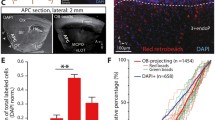Abstract
The laminar development of the external plexiform layer (EPL) in the rat main olfactory bulb and the postnatal development of parvalbumin-immunoreactive [PV(+)] neurons mainly located in this layer were studied in animals at postnatal week 1–4 at a light microscopic level. The EPL in the adult olfactory bulb consists of two sublayers, the inner sublayer (ISL) and the outer sublayer (OSL). The ISL was already developed well even at postnatal day 7 (P7), whereas the OSL was first recognized at P10 as a thin zone consisting of more or less loosely packed large-sized and small-to-medium-sized somata subjacent to the glomerular layer (GL). The OSL increased in thickness and came to occupy nearly one-third to -half of the EPL at P14. PV(+) neurons first appeared at P10 mainly in the inner border of EPL. Only a few PV(+) neurons were scattered in the EPL at P10, but they increased remarkably in number during P14–21. Some of these PV(+) neurons at P10 had an intensely immunoreactive soma, extending relatively long processes with varicosities and/or spines. At P14, PV(+) neurons were located not only in the ISL but also at the border between the ISL and OSL, but in the OSL proper they were rarely observed. These PV(+) neurons showed branched and complicated processes with numerous varicosities and spines, displaying more mature features than those in previous stages. Even at P14 many of these PV(+) neurons appeared to exhibit some characteristic structural features of those in the adult stage. At P21, PV(+) neurons were observed in the OSL and thus showed almost the adult pattern in their distribution and morphological features. The present study showed the development of PV(+) neurons in the rat main olfactory bulb and the difference between the ISL and OSL of the EPL in postnatal development.
Similar content being viewed by others
References
Bayer SA (1983) [3H]thymidine-radiographic studies of neurogenesis in the rat olfactory bulb. Exp Brain Res 50:329–340
Brunjes P, Frazier L (1986) Maturation and plasticity in the olfactory system of vertebrates. Brain Res Rev 11:1–45
Halász N, Shepherd GM (1983) Neurochemistry of the vertebrate olfactory bulb. Neuroscience 10:579–619
Hsu S-M, Raine L, Fanger H (1981) Use of avidin-biotin-peroxidase complex (ABC) in immunoperoxidase techniques. J Histochem Cytochem 29:577–580
Kägi U, Berchtold MW, Heizmann CW (1987) Ca2+-binding parvalbumin in the rat testis: characterization, localization, and expression during development. J Biol Chem 262:7314–7320
Kosaka K, Hama K, Nagatsu I, Wu J-Y, Ottersen OP, Storm-Mathisen J, Kosaka T (1987) Postnatal development of neurons containing both catecholaminergic and GABAergic traits in the rat main olfactory bulb. Brain Res 403:355–360
Kosaka K, Taomoto K, Nagatsu I, Heizmann CW, Hunziker W, Kosaka T (1992) Postnatal X-ray irradiation effects on glomerular layer of rat olfactory bulb: quantitative and immunocytochemical analysis. Exp Brain Res 90:103–115
Kosaka K, Heizmann CW, Kosaka T (1994) Calcium-binding protein parvalbumin-immunoreactive neurons in the rat olfactory bulb. 1. Distribution and structural features in adult rat. Exp Brain Res ζ:ζζ-ζζ
Kosaka T, Nagatsu I, Wu J-Y, Hama K (1986) Use of high concentrations of glutaraldehyde for immunocytochemistry of transmitter-synthesizing enzymes in the central nervous system. Neuroscience 18:975–990
Kosaka T, Kosaka K, Hataguchi Y, Nagatsu I, Wu J-Y, Ottersen OP, Storm-Mathisen J, Hama K (1987a) Catecholaminergic neurons containing GABA-like and/or glutamic acid decarboxylase-like immunoreactivities in various brain regions of the rat. Exp Brain Res 66:191–210
Kosaka T, Kosaka K, Heizmann CW, Nagatsu I, Wu J-Y, Yanaihara N, Hama K (1987b) An aspect of the organization of the GABAergic system in the rat main olfactory bulb: laminar distribution of immunohistochemically defined subpopulations of GABAergib neurons. Brain Res 411:373–378
Mair RG, Gellman RL, Gesteland RC (1982) Postnatal proliferation and maturation of olfactory bulb neurons in the rat. Neuroscience 7:3105–3116
Matsutani S, Senba E, Tohyama M (1988) Neuropeptide- and neurotransmitter-related immunoreactivities in the developing rat olfactory bulb. J Comp Neurol 272:331–342
McLean JH, Shipley MT (1988) Postmitotic, postmigrational expression of tyrosine hydroxylase in olfactory bulb dopaminergic neurons. J Neurosci 8:3658–3669
Orona E, Scott JW, Rainer EC (1983) Different granule cell populations innervate superficial and deep regions of the external plexiform layer in rat olfactory bulb. J Comp Neurol 217:227–237
Orona E, Rainer EC, Scott JW (1984) Dendritic and axonal organization of mitral and tufted cells in the rat olfactory bulb. J Comp Neurol 226:346–356
Solbach S, Celio MR (1991) Ontogeny of the calcium binding protein parvalbumin in the rat nervous system. Anat Embryol 184:103–124
Author information
Authors and Affiliations
Rights and permissions
About this article
Cite this article
Kosaka, K., Heizmann, C.W. & Kosaka, T. Calcium-binding protein parvalbumin-immunoreactive neurons in the rat olfactory bulb. Exp Brain Res 99, 205–213 (1994). https://doi.org/10.1007/BF00239587
Received:
Accepted:
Issue Date:
DOI: https://doi.org/10.1007/BF00239587




